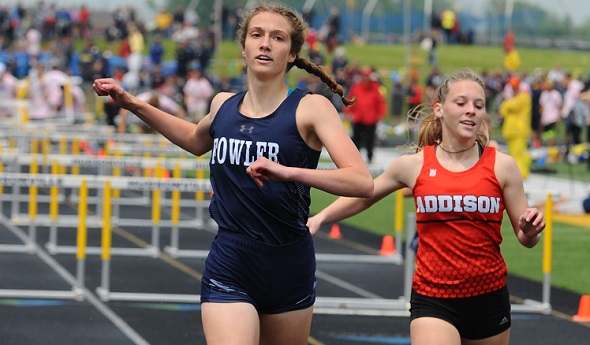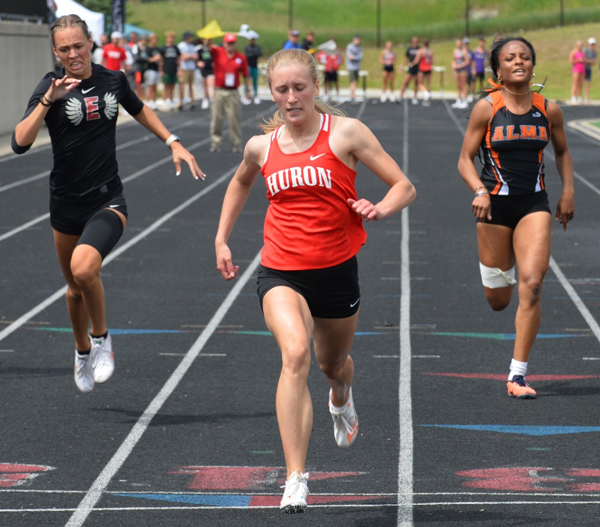
Motivated Fowler Continues Dominance
June 1, 2019
By Steve Vedder
Special for Second Half
HUDSONVILLE – It might not be the most talented team from a program that has dominated small-school girls track for nearly a decade.
But this year's Fowler team ranks among the best in terms of motivation.
It took a first place in the final event of Saturday's Lower Peninsula Division 4 Finals, but the Eagles successfully repeated as meet champions with a narrow eight-point win over runner-up Pittsford at blustery Baldwin Middle School. The title was Fowler's third in four years and fifth since 2011.
The difference between the latest championship and the previous four wasn't necessarily about talent, coach Jill Feldpausch said. It was more about motivation.
"We are a very motivated team," Feldpausch said following a wild meet that included three weather delays totaling more than five hours. "We're always a target, but winning the state title was our goal. We knew it wouldn't come easy, but it's one of the most hard-working teams we've had."
Fowler finished with only two first places, both by Alyssa Vandegriff, but added three seconds, a third and two fourths.
Vandegriff won her second consecutive 100-meter hurdles title (15.17) and also took first in the high jump (5-2). She said her expectations for back-to-back titles is much the same pressure as what her teammates faced.
"It's probably harder the second time. There is pressure on you to keep things up," said Vandegriff, who was second in the 100 hurdles as a sophomore and will run at Central Michigan University next spring. "A lot of it depends on the competition, and it fluctuates. Sometimes you wake up and you're just not feeling it."
 Feldpausch said the stick-out feature of this team was that the girls picked each other up.
Feldpausch said the stick-out feature of this team was that the girls picked each other up.
"Every team is special, and we haven't gotten everything we've wanted," she said. "That comes and goes with teams. But with this team, someone is always picking up someone else. We had 11 girls run today, but there were 20 on the bus."
Royal Oak Shrine's Ellie Kendell was a double winner in the 3,200 (11:21.58) and 1,600 (5:11.93). Bridgman's Mikaela Owen won the 200 (25.93) and 100 (12.46).
Other field event winners were Lyndsi Wolfe of Fulton in the discus, Frankfort's Tara Townsend in the pole vault, Maggie Stevenson of East Jordan in the shot and Ally McLouth of Addison in the long jump.
Other winners were Scout Nelson of Mount Pleasant Sacred Heart in the 800, Annie Laurenz of Breckenridge in the 300 hurdles and Annie Gunderman of Portland St. Patrick in the 400.
Pittsford won the 400 and 800 relays, while Sacred Heart captured the 1,600 and 3,200.
PHOTOS: (Top) Fowler’s Alyssa Vandegriff runs through the finish in repeating as 100 hurdles champion Saturday. (Middle) Royal Oak Shrine's Ellie Kendell charges to one of her two race championships. (Click to see more from RunMichigan.com.)

Multi-Sprint Champ Racing to Finish Huron Career Ahead of the Rest Again
By
Keith Dunlap
Special for MHSAA.com
May 25, 2023
NEW BOSTON – If there was one thing Elizabeth Anderson took pride in elementary school, it was simply showing that she could outrun everyone in sight.
 In fact, Anderson has an explanation for all the success she had in those playground races.
In fact, Anderson has an explanation for all the success she had in those playground races.
“Dominance when you are in elementary school,” Anderson quipped. “I don’t think I ever had a nickname. I just think everyone knew I was fast.”
Years later, pretty much everyone who follows track & field in the state of Michigan can attest to that.
A senior for New Boston Huron, Anderson has been faster than most other competitors in the state during her three-year high school career (with her freshman season in 2020 canceled due to COVID-19).
Last year, Anderson won titles at the Lower Peninsula Division 2 Finals in the 200-meter (25.07) and 400-meter (56.28) dashes, and was runner-up in the 100-meter dash (12.23).
Often, top sprinters focus on one or two of those three races. But Anderson is certainly a different breed of sprinter because she does all three.
In fact, she holds school records in all three of those events, and if all that weren’t enough, Anderson is a part of all three sprint relay teams.
“It is hard to give her events off,” said New Boston Huron head girls track coach Danielle Lobato.
Despite the different styles the 100, 200 and 400-meter dashes present, Anderson said there usually isn’t much adjusting when she goes from one of those races to another.
 The strategy is simply, “Let’s beat the other girls to the finish line.”
The strategy is simply, “Let’s beat the other girls to the finish line.”
“I don’t really go into each race changing up how I would run,” she said.
While enjoying and succeeding in all three races, Anderson said she actually does have a favorite among them.
“I would say the 400 is probably my favorite,” she said. “Even though it hurts, it’s satisfying to see how much you can get your time down in the 400 compared to any other race.”
Anderson said she started running track in sixth grade, but really got serious about it during the summer after her sophomore season, when she was invited to run for a local club.
Eventually, that led to her competing over the winter in indoor events.
She lived and breathed track so much that last fall, she decided to not run cross country so she could focus on a weightlifting regimen aimed at developing more leg strength.
“Once I started doing summer track, I realized I wanted to be doing this all the time,” she said.
Lobato said oftentimes in practice, Anderson is a de facto coach, given there is no better person she can think of for the younger runners on the team to learn from.
“I can’t always demonstrate these things I’m trying to teach,” she said. “You get to see it in real life (from Anderson), not in a YouTube video.”
After winning the 100, 200 and 400-meter dashes at her Regional meet last week, Anderson has her sights set on achieving the same trifecta of titles at next Saturday’s Finals in Grand Rapids.
Anderson has signed to run track at Michigan State, but has been plenty motivated to keep producing this spring in her final high school season.
“I’m really looking to defend my titles,” she said. “That is what is really motivating me to keep going. I want to keep in shape for the college season. I don’t want to lose any of the progress I have made. Ultimately, I just love running track.”
And since elementary school, Anderson has loved — and succeeded in — outrunning everyone else to the finish line.
“We knew we were getting something special,” Lobato said of when Anderson arrived in high school. “But you never expect this. All that she has accomplished is amazing.”
 Keith Dunlap has served in Detroit-area sports media for more than two decades, including as a sportswriter at the Oakland Press from 2001-16 primarily covering high school sports but also college and professional teams. His bylines also have appeared in USA Today, the Washington Post, the Detroit Free Press, the Houston Chronicle and the Boston Globe. He served as the administrator for the Oakland Activities Association’s website from 2017-2020. Contact him at [email protected] with story ideas for Oakland, Macomb and Wayne counties
Keith Dunlap has served in Detroit-area sports media for more than two decades, including as a sportswriter at the Oakland Press from 2001-16 primarily covering high school sports but also college and professional teams. His bylines also have appeared in USA Today, the Washington Post, the Detroit Free Press, the Houston Chronicle and the Boston Globe. He served as the administrator for the Oakland Activities Association’s website from 2017-2020. Contact him at [email protected] with story ideas for Oakland, Macomb and Wayne counties
PHOTOS (Top) New Boston Huron's Elizabeth Anderson clears the finish line during last season's LPD2 400 race. (Middle) Anderson, middle, outpaces the field to also win the 200. (Click for more from RunMichigan.com.)

